Business Communication Skills INTRODUCTION
VerifiedAdded on 2022/12/26
|14
|3757
|153
AI Summary
Business Communication Skills INTRODUCTION .3 TASK 1 3 1.1 Communication models and systems used in businesses3 .5 1.2 Communication methods used by businesses and benefits of formal and informal communication 6 1.3 Use of technology in different types of communication in business environment .7 1.4 Outline of the principles of effective communication .8 1.5 Barriers to effective communication:9 TASK 2 9 2.1 Oral Communication.9 2.2 Role play .10 TASK 311 3.1 Formal evidences for showcasing written communication skills
Contribute Materials
Your contribution can guide someone’s learning journey. Share your
documents today.
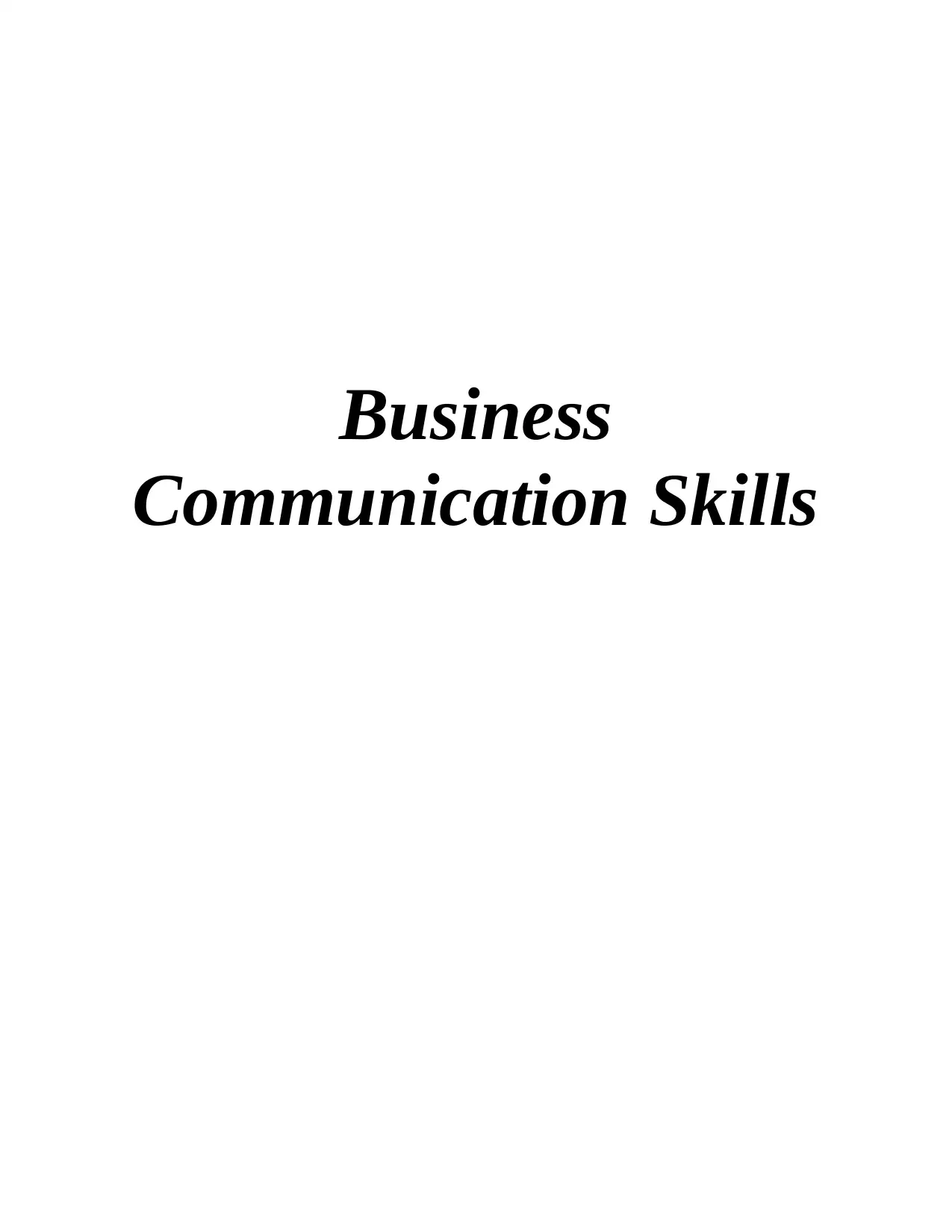
Business
Communication Skills
Communication Skills
Secure Best Marks with AI Grader
Need help grading? Try our AI Grader for instant feedback on your assignments.
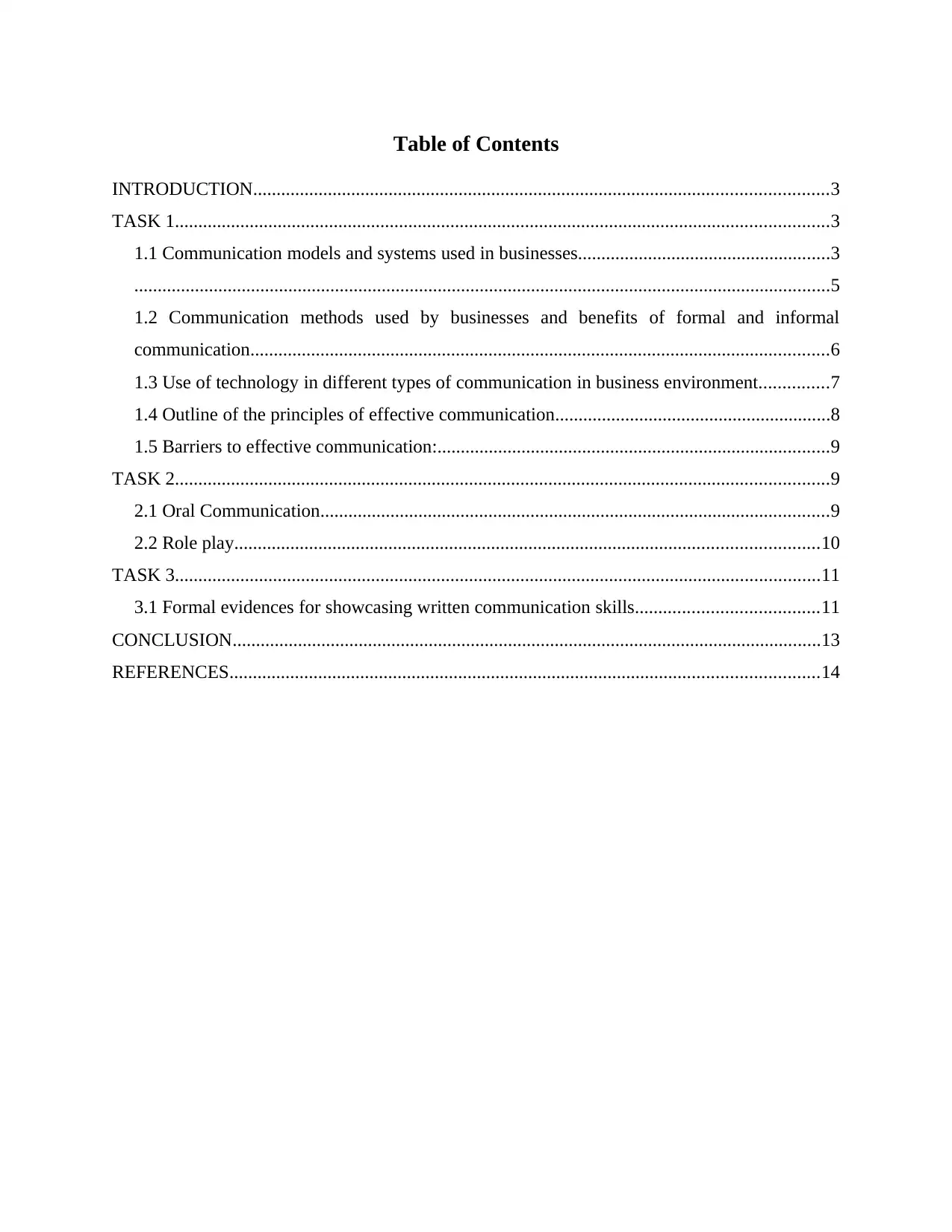
Table of Contents
INTRODUCTION...........................................................................................................................3
TASK 1............................................................................................................................................3
1.1 Communication models and systems used in businesses......................................................3
.....................................................................................................................................................5
1.2 Communication methods used by businesses and benefits of formal and informal
communication............................................................................................................................6
1.3 Use of technology in different types of communication in business environment...............7
1.4 Outline of the principles of effective communication...........................................................8
1.5 Barriers to effective communication:....................................................................................9
TASK 2............................................................................................................................................9
2.1 Oral Communication.............................................................................................................9
2.2 Role play.............................................................................................................................10
TASK 3..........................................................................................................................................11
3.1 Formal evidences for showcasing written communication skills.......................................11
CONCLUSION..............................................................................................................................13
REFERENCES..............................................................................................................................14
INTRODUCTION...........................................................................................................................3
TASK 1............................................................................................................................................3
1.1 Communication models and systems used in businesses......................................................3
.....................................................................................................................................................5
1.2 Communication methods used by businesses and benefits of formal and informal
communication............................................................................................................................6
1.3 Use of technology in different types of communication in business environment...............7
1.4 Outline of the principles of effective communication...........................................................8
1.5 Barriers to effective communication:....................................................................................9
TASK 2............................................................................................................................................9
2.1 Oral Communication.............................................................................................................9
2.2 Role play.............................................................................................................................10
TASK 3..........................................................................................................................................11
3.1 Formal evidences for showcasing written communication skills.......................................11
CONCLUSION..............................................................................................................................13
REFERENCES..............................................................................................................................14
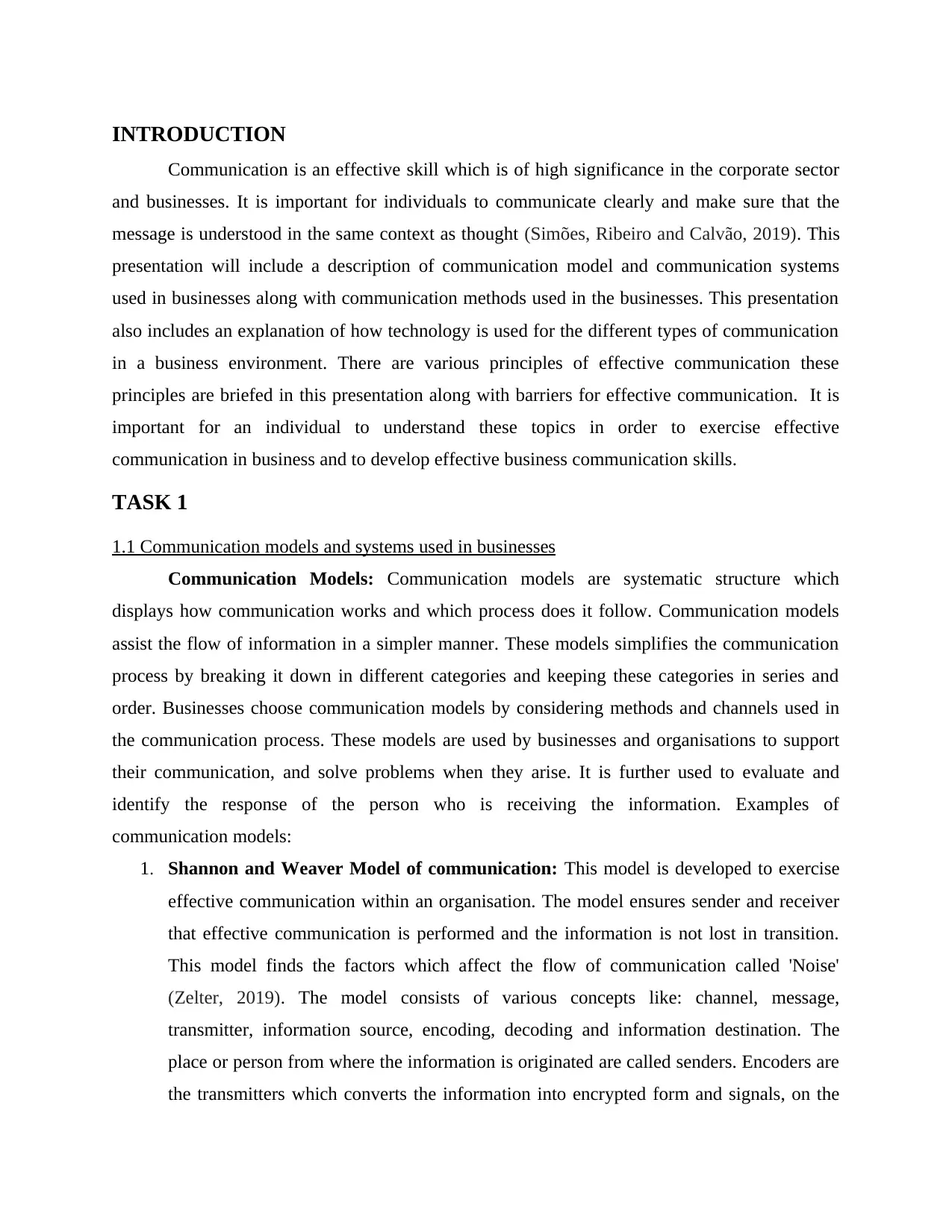
INTRODUCTION
Communication is an effective skill which is of high significance in the corporate sector
and businesses. It is important for individuals to communicate clearly and make sure that the
message is understood in the same context as thought (Simões, Ribeiro and Calvão, 2019). This
presentation will include a description of communication model and communication systems
used in businesses along with communication methods used in the businesses. This presentation
also includes an explanation of how technology is used for the different types of communication
in a business environment. There are various principles of effective communication these
principles are briefed in this presentation along with barriers for effective communication. It is
important for an individual to understand these topics in order to exercise effective
communication in business and to develop effective business communication skills.
TASK 1
1.1 Communication models and systems used in businesses
Communication Models: Communication models are systematic structure which
displays how communication works and which process does it follow. Communication models
assist the flow of information in a simpler manner. These models simplifies the communication
process by breaking it down in different categories and keeping these categories in series and
order. Businesses choose communication models by considering methods and channels used in
the communication process. These models are used by businesses and organisations to support
their communication, and solve problems when they arise. It is further used to evaluate and
identify the response of the person who is receiving the information. Examples of
communication models:
1. Shannon and Weaver Model of communication: This model is developed to exercise
effective communication within an organisation. The model ensures sender and receiver
that effective communication is performed and the information is not lost in transition.
This model finds the factors which affect the flow of communication called 'Noise'
(Zelter, 2019). The model consists of various concepts like: channel, message,
transmitter, information source, encoding, decoding and information destination. The
place or person from where the information is originated are called senders. Encoders are
the transmitters which converts the information into encrypted form and signals, on the
Communication is an effective skill which is of high significance in the corporate sector
and businesses. It is important for individuals to communicate clearly and make sure that the
message is understood in the same context as thought (Simões, Ribeiro and Calvão, 2019). This
presentation will include a description of communication model and communication systems
used in businesses along with communication methods used in the businesses. This presentation
also includes an explanation of how technology is used for the different types of communication
in a business environment. There are various principles of effective communication these
principles are briefed in this presentation along with barriers for effective communication. It is
important for an individual to understand these topics in order to exercise effective
communication in business and to develop effective business communication skills.
TASK 1
1.1 Communication models and systems used in businesses
Communication Models: Communication models are systematic structure which
displays how communication works and which process does it follow. Communication models
assist the flow of information in a simpler manner. These models simplifies the communication
process by breaking it down in different categories and keeping these categories in series and
order. Businesses choose communication models by considering methods and channels used in
the communication process. These models are used by businesses and organisations to support
their communication, and solve problems when they arise. It is further used to evaluate and
identify the response of the person who is receiving the information. Examples of
communication models:
1. Shannon and Weaver Model of communication: This model is developed to exercise
effective communication within an organisation. The model ensures sender and receiver
that effective communication is performed and the information is not lost in transition.
This model finds the factors which affect the flow of communication called 'Noise'
(Zelter, 2019). The model consists of various concepts like: channel, message,
transmitter, information source, encoding, decoding and information destination. The
place or person from where the information is originated are called senders. Encoders are
the transmitters which converts the information into encrypted form and signals, on the
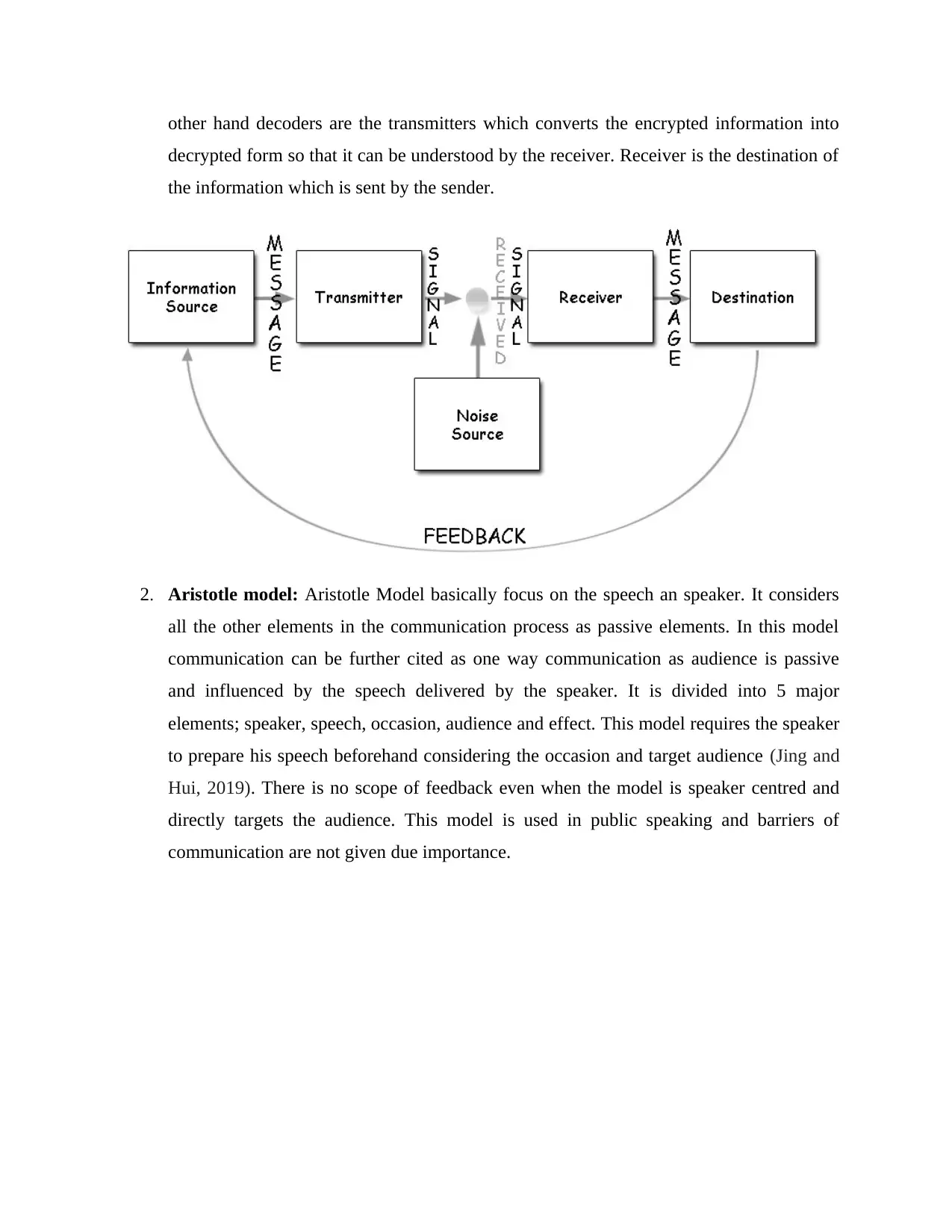
other hand decoders are the transmitters which converts the encrypted information into
decrypted form so that it can be understood by the receiver. Receiver is the destination of
the information which is sent by the sender.
2. Aristotle model: Aristotle Model basically focus on the speech an speaker. It considers
all the other elements in the communication process as passive elements. In this model
communication can be further cited as one way communication as audience is passive
and influenced by the speech delivered by the speaker. It is divided into 5 major
elements; speaker, speech, occasion, audience and effect. This model requires the speaker
to prepare his speech beforehand considering the occasion and target audience (Jing and
Hui, 2019). There is no scope of feedback even when the model is speaker centred and
directly targets the audience. This model is used in public speaking and barriers of
communication are not given due importance.
decrypted form so that it can be understood by the receiver. Receiver is the destination of
the information which is sent by the sender.
2. Aristotle model: Aristotle Model basically focus on the speech an speaker. It considers
all the other elements in the communication process as passive elements. In this model
communication can be further cited as one way communication as audience is passive
and influenced by the speech delivered by the speaker. It is divided into 5 major
elements; speaker, speech, occasion, audience and effect. This model requires the speaker
to prepare his speech beforehand considering the occasion and target audience (Jing and
Hui, 2019). There is no scope of feedback even when the model is speaker centred and
directly targets the audience. This model is used in public speaking and barriers of
communication are not given due importance.
Secure Best Marks with AI Grader
Need help grading? Try our AI Grader for instant feedback on your assignments.
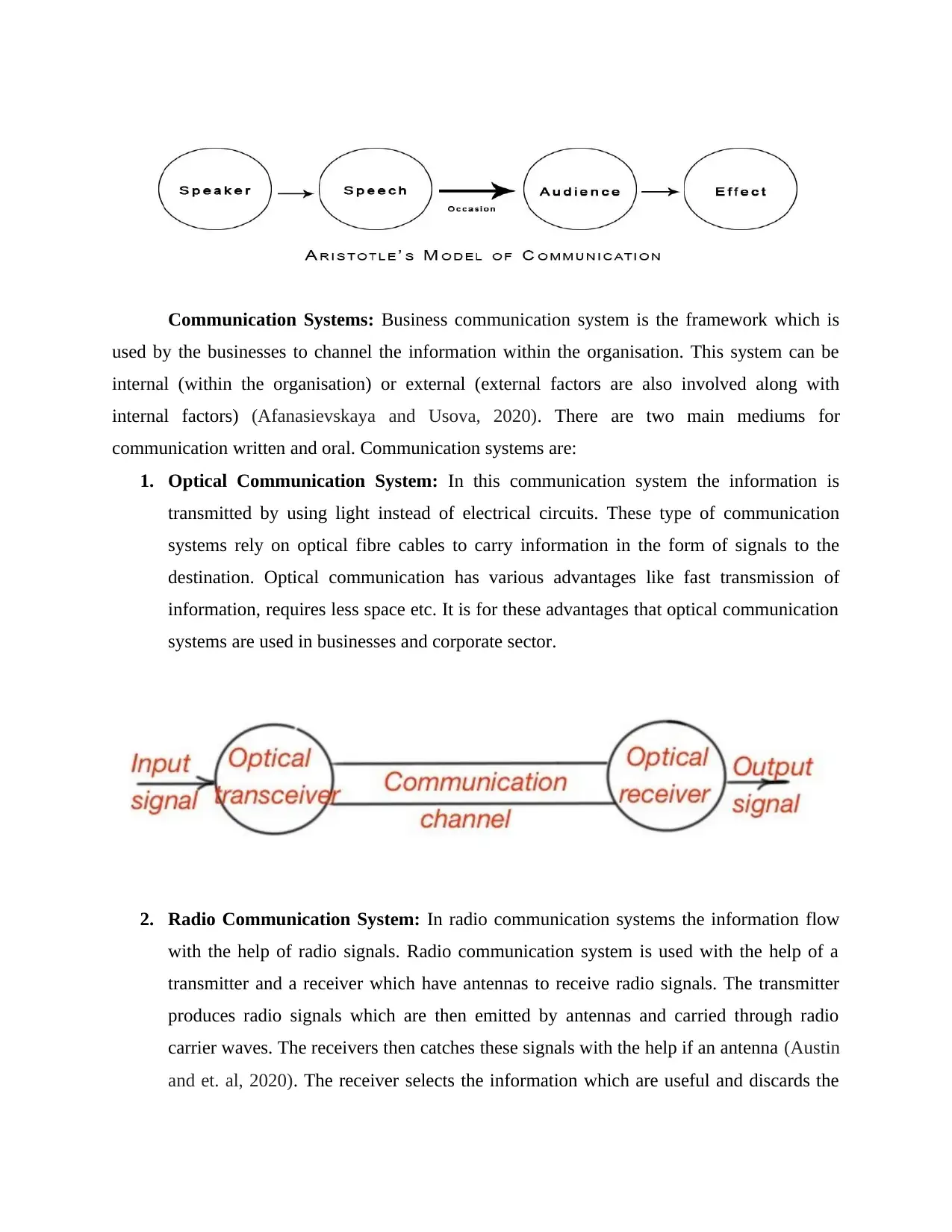
Communication Systems: Business communication system is the framework which is
used by the businesses to channel the information within the organisation. This system can be
internal (within the organisation) or external (external factors are also involved along with
internal factors) (Afanasievskaya and Usova, 2020). There are two main mediums for
communication written and oral. Communication systems are:
1. Optical Communication System: In this communication system the information is
transmitted by using light instead of electrical circuits. These type of communication
systems rely on optical fibre cables to carry information in the form of signals to the
destination. Optical communication has various advantages like fast transmission of
information, requires less space etc. It is for these advantages that optical communication
systems are used in businesses and corporate sector.
2. Radio Communication System: In radio communication systems the information flow
with the help of radio signals. Radio communication system is used with the help of a
transmitter and a receiver which have antennas to receive radio signals. The transmitter
produces radio signals which are then emitted by antennas and carried through radio
carrier waves. The receivers then catches these signals with the help if an antenna (Austin
and et. al, 2020). The receiver selects the information which are useful and discards the
used by the businesses to channel the information within the organisation. This system can be
internal (within the organisation) or external (external factors are also involved along with
internal factors) (Afanasievskaya and Usova, 2020). There are two main mediums for
communication written and oral. Communication systems are:
1. Optical Communication System: In this communication system the information is
transmitted by using light instead of electrical circuits. These type of communication
systems rely on optical fibre cables to carry information in the form of signals to the
destination. Optical communication has various advantages like fast transmission of
information, requires less space etc. It is for these advantages that optical communication
systems are used in businesses and corporate sector.
2. Radio Communication System: In radio communication systems the information flow
with the help of radio signals. Radio communication system is used with the help of a
transmitter and a receiver which have antennas to receive radio signals. The transmitter
produces radio signals which are then emitted by antennas and carried through radio
carrier waves. The receivers then catches these signals with the help if an antenna (Austin
and et. al, 2020). The receiver selects the information which are useful and discards the
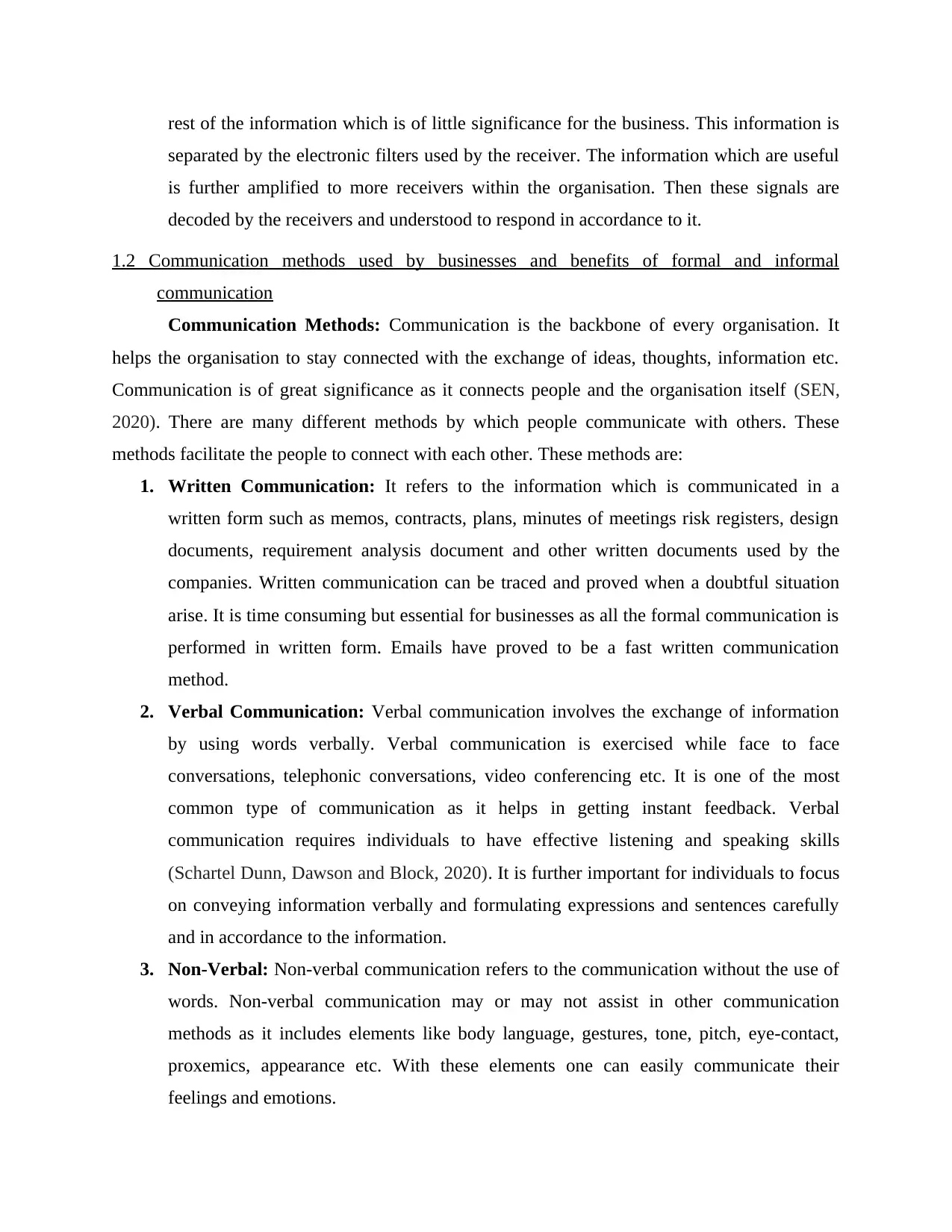
rest of the information which is of little significance for the business. This information is
separated by the electronic filters used by the receiver. The information which are useful
is further amplified to more receivers within the organisation. Then these signals are
decoded by the receivers and understood to respond in accordance to it.
1.2 Communication methods used by businesses and benefits of formal and informal
communication
Communication Methods: Communication is the backbone of every organisation. It
helps the organisation to stay connected with the exchange of ideas, thoughts, information etc.
Communication is of great significance as it connects people and the organisation itself (SEN,
2020). There are many different methods by which people communicate with others. These
methods facilitate the people to connect with each other. These methods are:
1. Written Communication: It refers to the information which is communicated in a
written form such as memos, contracts, plans, minutes of meetings risk registers, design
documents, requirement analysis document and other written documents used by the
companies. Written communication can be traced and proved when a doubtful situation
arise. It is time consuming but essential for businesses as all the formal communication is
performed in written form. Emails have proved to be a fast written communication
method.
2. Verbal Communication: Verbal communication involves the exchange of information
by using words verbally. Verbal communication is exercised while face to face
conversations, telephonic conversations, video conferencing etc. It is one of the most
common type of communication as it helps in getting instant feedback. Verbal
communication requires individuals to have effective listening and speaking skills
(Schartel Dunn, Dawson and Block, 2020). It is further important for individuals to focus
on conveying information verbally and formulating expressions and sentences carefully
and in accordance to the information.
3. Non-Verbal: Non-verbal communication refers to the communication without the use of
words. Non-verbal communication may or may not assist in other communication
methods as it includes elements like body language, gestures, tone, pitch, eye-contact,
proxemics, appearance etc. With these elements one can easily communicate their
feelings and emotions.
separated by the electronic filters used by the receiver. The information which are useful
is further amplified to more receivers within the organisation. Then these signals are
decoded by the receivers and understood to respond in accordance to it.
1.2 Communication methods used by businesses and benefits of formal and informal
communication
Communication Methods: Communication is the backbone of every organisation. It
helps the organisation to stay connected with the exchange of ideas, thoughts, information etc.
Communication is of great significance as it connects people and the organisation itself (SEN,
2020). There are many different methods by which people communicate with others. These
methods facilitate the people to connect with each other. These methods are:
1. Written Communication: It refers to the information which is communicated in a
written form such as memos, contracts, plans, minutes of meetings risk registers, design
documents, requirement analysis document and other written documents used by the
companies. Written communication can be traced and proved when a doubtful situation
arise. It is time consuming but essential for businesses as all the formal communication is
performed in written form. Emails have proved to be a fast written communication
method.
2. Verbal Communication: Verbal communication involves the exchange of information
by using words verbally. Verbal communication is exercised while face to face
conversations, telephonic conversations, video conferencing etc. It is one of the most
common type of communication as it helps in getting instant feedback. Verbal
communication requires individuals to have effective listening and speaking skills
(Schartel Dunn, Dawson and Block, 2020). It is further important for individuals to focus
on conveying information verbally and formulating expressions and sentences carefully
and in accordance to the information.
3. Non-Verbal: Non-verbal communication refers to the communication without the use of
words. Non-verbal communication may or may not assist in other communication
methods as it includes elements like body language, gestures, tone, pitch, eye-contact,
proxemics, appearance etc. With these elements one can easily communicate their
feelings and emotions.
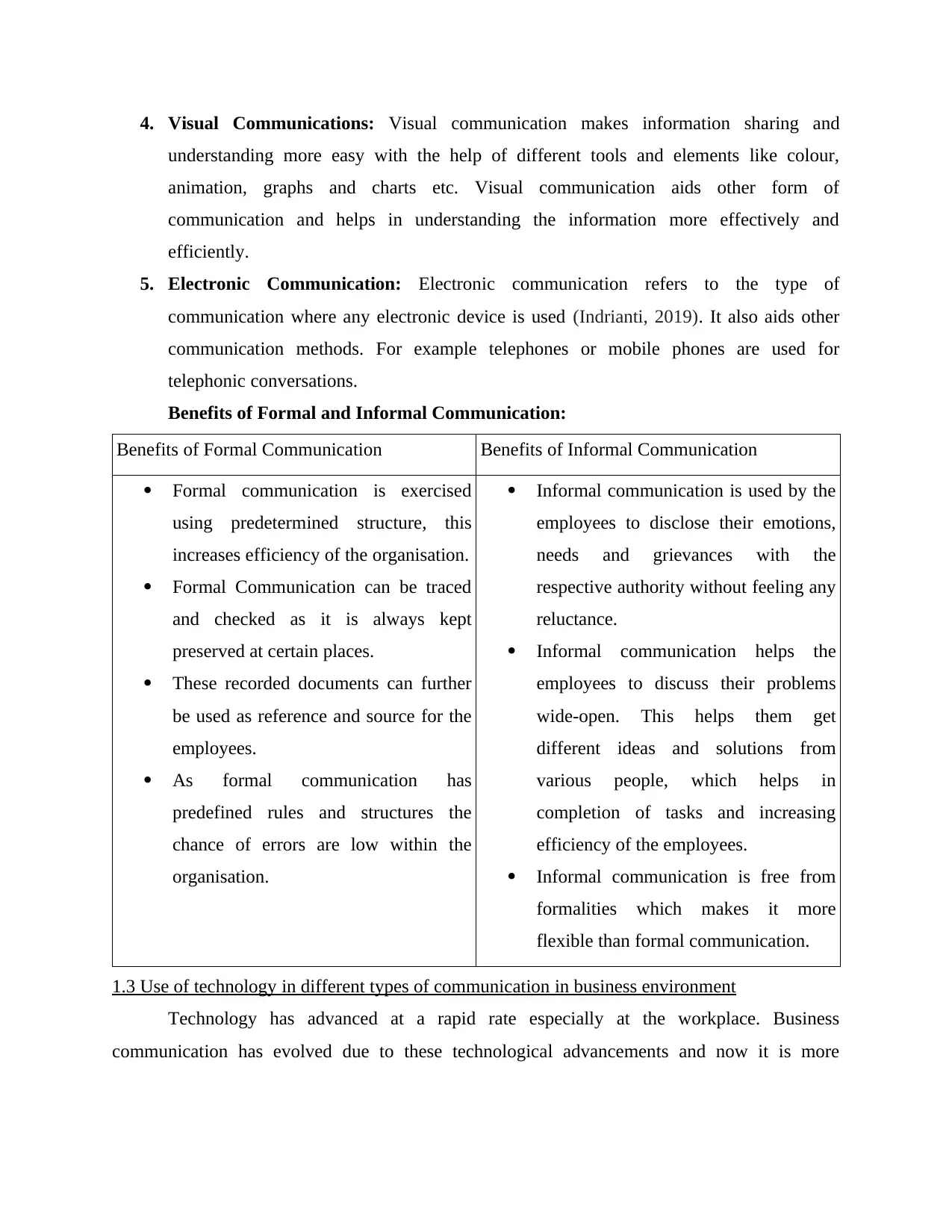
4. Visual Communications: Visual communication makes information sharing and
understanding more easy with the help of different tools and elements like colour,
animation, graphs and charts etc. Visual communication aids other form of
communication and helps in understanding the information more effectively and
efficiently.
5. Electronic Communication: Electronic communication refers to the type of
communication where any electronic device is used (Indrianti, 2019). It also aids other
communication methods. For example telephones or mobile phones are used for
telephonic conversations.
Benefits of Formal and Informal Communication:
Benefits of Formal Communication Benefits of Informal Communication
Formal communication is exercised
using predetermined structure, this
increases efficiency of the organisation.
Formal Communication can be traced
and checked as it is always kept
preserved at certain places.
These recorded documents can further
be used as reference and source for the
employees.
As formal communication has
predefined rules and structures the
chance of errors are low within the
organisation.
Informal communication is used by the
employees to disclose their emotions,
needs and grievances with the
respective authority without feeling any
reluctance.
Informal communication helps the
employees to discuss their problems
wide-open. This helps them get
different ideas and solutions from
various people, which helps in
completion of tasks and increasing
efficiency of the employees.
Informal communication is free from
formalities which makes it more
flexible than formal communication.
1.3 Use of technology in different types of communication in business environment
Technology has advanced at a rapid rate especially at the workplace. Business
communication has evolved due to these technological advancements and now it is more
understanding more easy with the help of different tools and elements like colour,
animation, graphs and charts etc. Visual communication aids other form of
communication and helps in understanding the information more effectively and
efficiently.
5. Electronic Communication: Electronic communication refers to the type of
communication where any electronic device is used (Indrianti, 2019). It also aids other
communication methods. For example telephones or mobile phones are used for
telephonic conversations.
Benefits of Formal and Informal Communication:
Benefits of Formal Communication Benefits of Informal Communication
Formal communication is exercised
using predetermined structure, this
increases efficiency of the organisation.
Formal Communication can be traced
and checked as it is always kept
preserved at certain places.
These recorded documents can further
be used as reference and source for the
employees.
As formal communication has
predefined rules and structures the
chance of errors are low within the
organisation.
Informal communication is used by the
employees to disclose their emotions,
needs and grievances with the
respective authority without feeling any
reluctance.
Informal communication helps the
employees to discuss their problems
wide-open. This helps them get
different ideas and solutions from
various people, which helps in
completion of tasks and increasing
efficiency of the employees.
Informal communication is free from
formalities which makes it more
flexible than formal communication.
1.3 Use of technology in different types of communication in business environment
Technology has advanced at a rapid rate especially at the workplace. Business
communication has evolved due to these technological advancements and now it is more
Paraphrase This Document
Need a fresh take? Get an instant paraphrase of this document with our AI Paraphraser
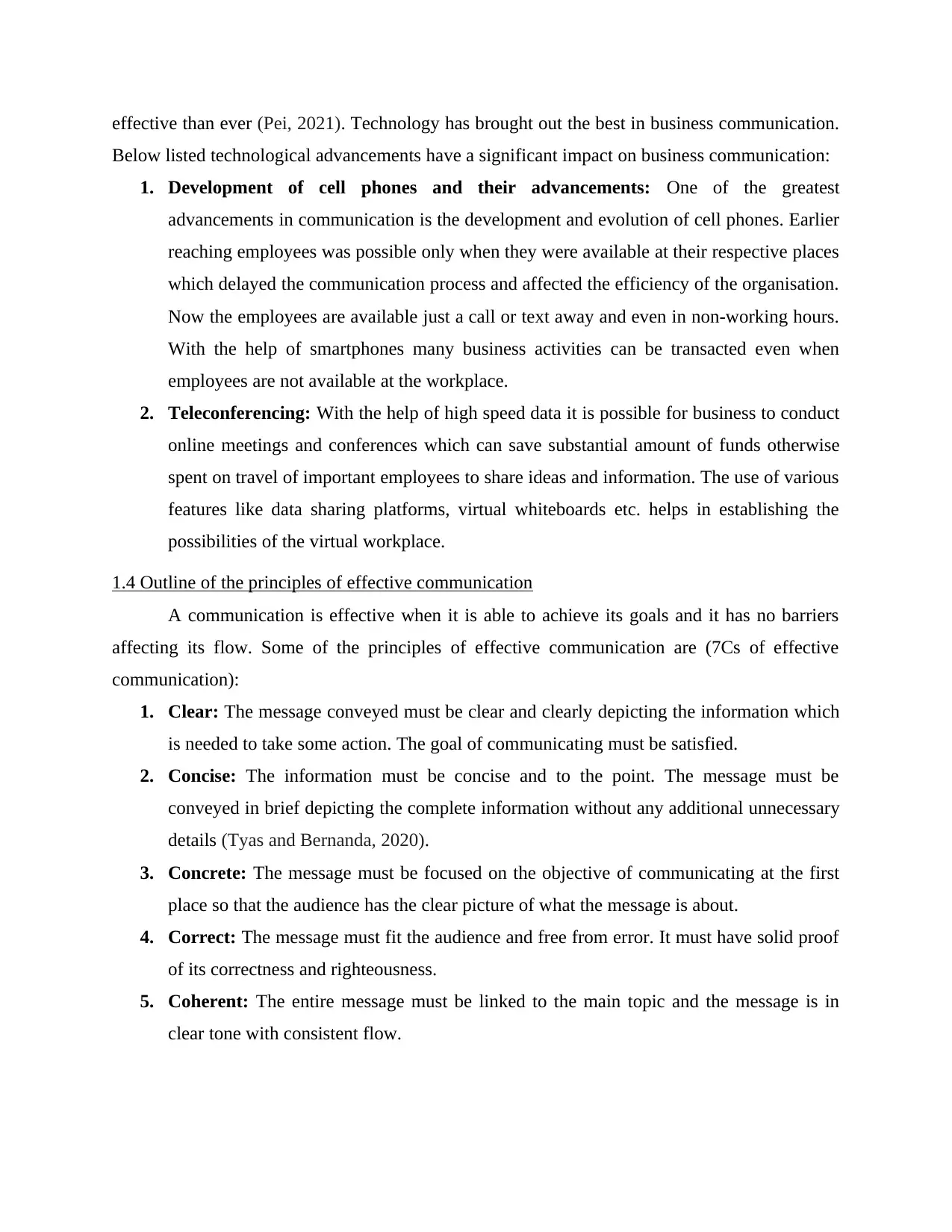
effective than ever (Pei, 2021). Technology has brought out the best in business communication.
Below listed technological advancements have a significant impact on business communication:
1. Development of cell phones and their advancements: One of the greatest
advancements in communication is the development and evolution of cell phones. Earlier
reaching employees was possible only when they were available at their respective places
which delayed the communication process and affected the efficiency of the organisation.
Now the employees are available just a call or text away and even in non-working hours.
With the help of smartphones many business activities can be transacted even when
employees are not available at the workplace.
2. Teleconferencing: With the help of high speed data it is possible for business to conduct
online meetings and conferences which can save substantial amount of funds otherwise
spent on travel of important employees to share ideas and information. The use of various
features like data sharing platforms, virtual whiteboards etc. helps in establishing the
possibilities of the virtual workplace.
1.4 Outline of the principles of effective communication
A communication is effective when it is able to achieve its goals and it has no barriers
affecting its flow. Some of the principles of effective communication are (7Cs of effective
communication):
1. Clear: The message conveyed must be clear and clearly depicting the information which
is needed to take some action. The goal of communicating must be satisfied.
2. Concise: The information must be concise and to the point. The message must be
conveyed in brief depicting the complete information without any additional unnecessary
details (Tyas and Bernanda, 2020).
3. Concrete: The message must be focused on the objective of communicating at the first
place so that the audience has the clear picture of what the message is about.
4. Correct: The message must fit the audience and free from error. It must have solid proof
of its correctness and righteousness.
5. Coherent: The entire message must be linked to the main topic and the message is in
clear tone with consistent flow.
Below listed technological advancements have a significant impact on business communication:
1. Development of cell phones and their advancements: One of the greatest
advancements in communication is the development and evolution of cell phones. Earlier
reaching employees was possible only when they were available at their respective places
which delayed the communication process and affected the efficiency of the organisation.
Now the employees are available just a call or text away and even in non-working hours.
With the help of smartphones many business activities can be transacted even when
employees are not available at the workplace.
2. Teleconferencing: With the help of high speed data it is possible for business to conduct
online meetings and conferences which can save substantial amount of funds otherwise
spent on travel of important employees to share ideas and information. The use of various
features like data sharing platforms, virtual whiteboards etc. helps in establishing the
possibilities of the virtual workplace.
1.4 Outline of the principles of effective communication
A communication is effective when it is able to achieve its goals and it has no barriers
affecting its flow. Some of the principles of effective communication are (7Cs of effective
communication):
1. Clear: The message conveyed must be clear and clearly depicting the information which
is needed to take some action. The goal of communicating must be satisfied.
2. Concise: The information must be concise and to the point. The message must be
conveyed in brief depicting the complete information without any additional unnecessary
details (Tyas and Bernanda, 2020).
3. Concrete: The message must be focused on the objective of communicating at the first
place so that the audience has the clear picture of what the message is about.
4. Correct: The message must fit the audience and free from error. It must have solid proof
of its correctness and righteousness.
5. Coherent: The entire message must be linked to the main topic and the message is in
clear tone with consistent flow.
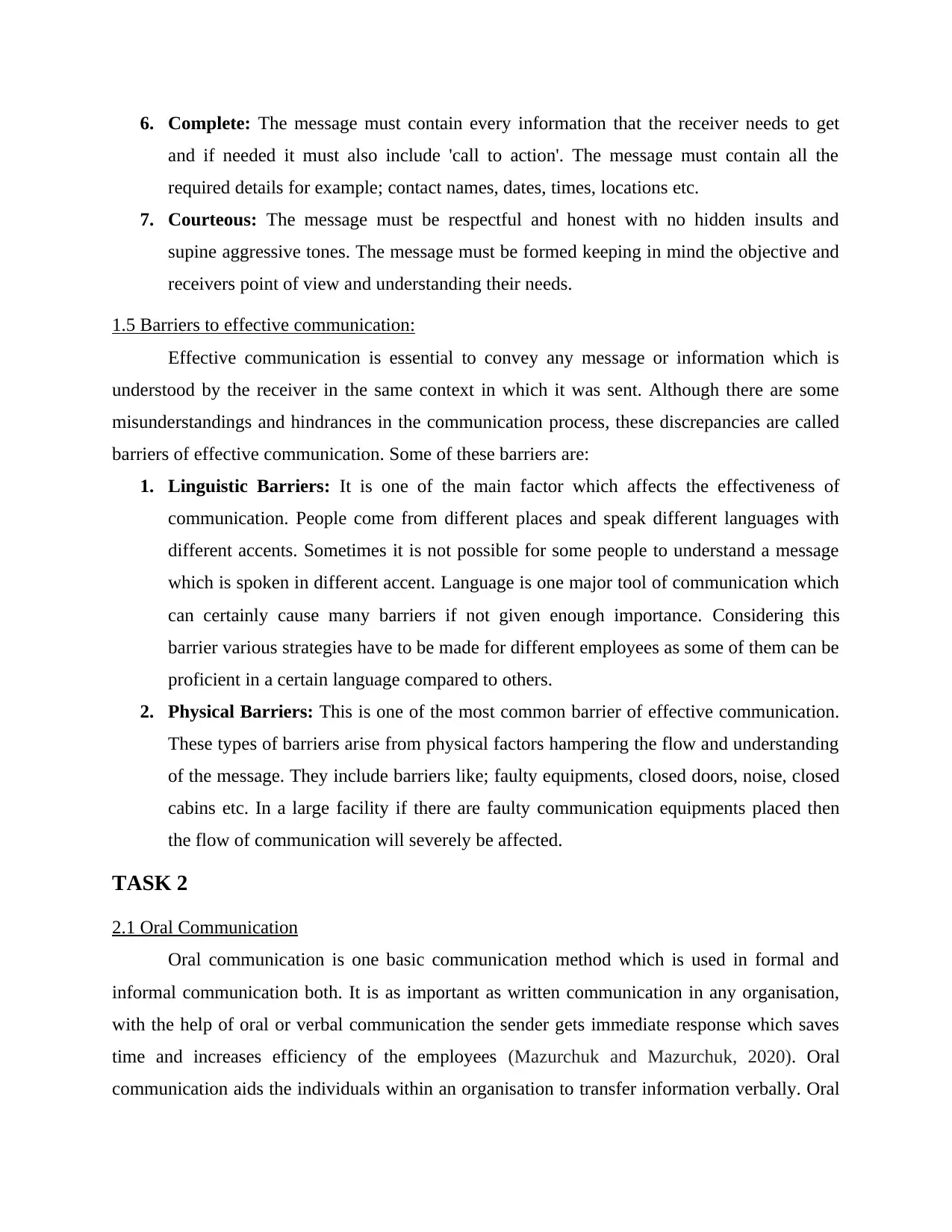
6. Complete: The message must contain every information that the receiver needs to get
and if needed it must also include 'call to action'. The message must contain all the
required details for example; contact names, dates, times, locations etc.
7. Courteous: The message must be respectful and honest with no hidden insults and
supine aggressive tones. The message must be formed keeping in mind the objective and
receivers point of view and understanding their needs.
1.5 Barriers to effective communication:
Effective communication is essential to convey any message or information which is
understood by the receiver in the same context in which it was sent. Although there are some
misunderstandings and hindrances in the communication process, these discrepancies are called
barriers of effective communication. Some of these barriers are:
1. Linguistic Barriers: It is one of the main factor which affects the effectiveness of
communication. People come from different places and speak different languages with
different accents. Sometimes it is not possible for some people to understand a message
which is spoken in different accent. Language is one major tool of communication which
can certainly cause many barriers if not given enough importance. Considering this
barrier various strategies have to be made for different employees as some of them can be
proficient in a certain language compared to others.
2. Physical Barriers: This is one of the most common barrier of effective communication.
These types of barriers arise from physical factors hampering the flow and understanding
of the message. They include barriers like; faulty equipments, closed doors, noise, closed
cabins etc. In a large facility if there are faulty communication equipments placed then
the flow of communication will severely be affected.
TASK 2
2.1 Oral Communication
Oral communication is one basic communication method which is used in formal and
informal communication both. It is as important as written communication in any organisation,
with the help of oral or verbal communication the sender gets immediate response which saves
time and increases efficiency of the employees (Mazurchuk and Mazurchuk, 2020). Oral
communication aids the individuals within an organisation to transfer information verbally. Oral
and if needed it must also include 'call to action'. The message must contain all the
required details for example; contact names, dates, times, locations etc.
7. Courteous: The message must be respectful and honest with no hidden insults and
supine aggressive tones. The message must be formed keeping in mind the objective and
receivers point of view and understanding their needs.
1.5 Barriers to effective communication:
Effective communication is essential to convey any message or information which is
understood by the receiver in the same context in which it was sent. Although there are some
misunderstandings and hindrances in the communication process, these discrepancies are called
barriers of effective communication. Some of these barriers are:
1. Linguistic Barriers: It is one of the main factor which affects the effectiveness of
communication. People come from different places and speak different languages with
different accents. Sometimes it is not possible for some people to understand a message
which is spoken in different accent. Language is one major tool of communication which
can certainly cause many barriers if not given enough importance. Considering this
barrier various strategies have to be made for different employees as some of them can be
proficient in a certain language compared to others.
2. Physical Barriers: This is one of the most common barrier of effective communication.
These types of barriers arise from physical factors hampering the flow and understanding
of the message. They include barriers like; faulty equipments, closed doors, noise, closed
cabins etc. In a large facility if there are faulty communication equipments placed then
the flow of communication will severely be affected.
TASK 2
2.1 Oral Communication
Oral communication is one basic communication method which is used in formal and
informal communication both. It is as important as written communication in any organisation,
with the help of oral or verbal communication the sender gets immediate response which saves
time and increases efficiency of the employees (Mazurchuk and Mazurchuk, 2020). Oral
communication aids the individuals within an organisation to transfer information verbally. Oral
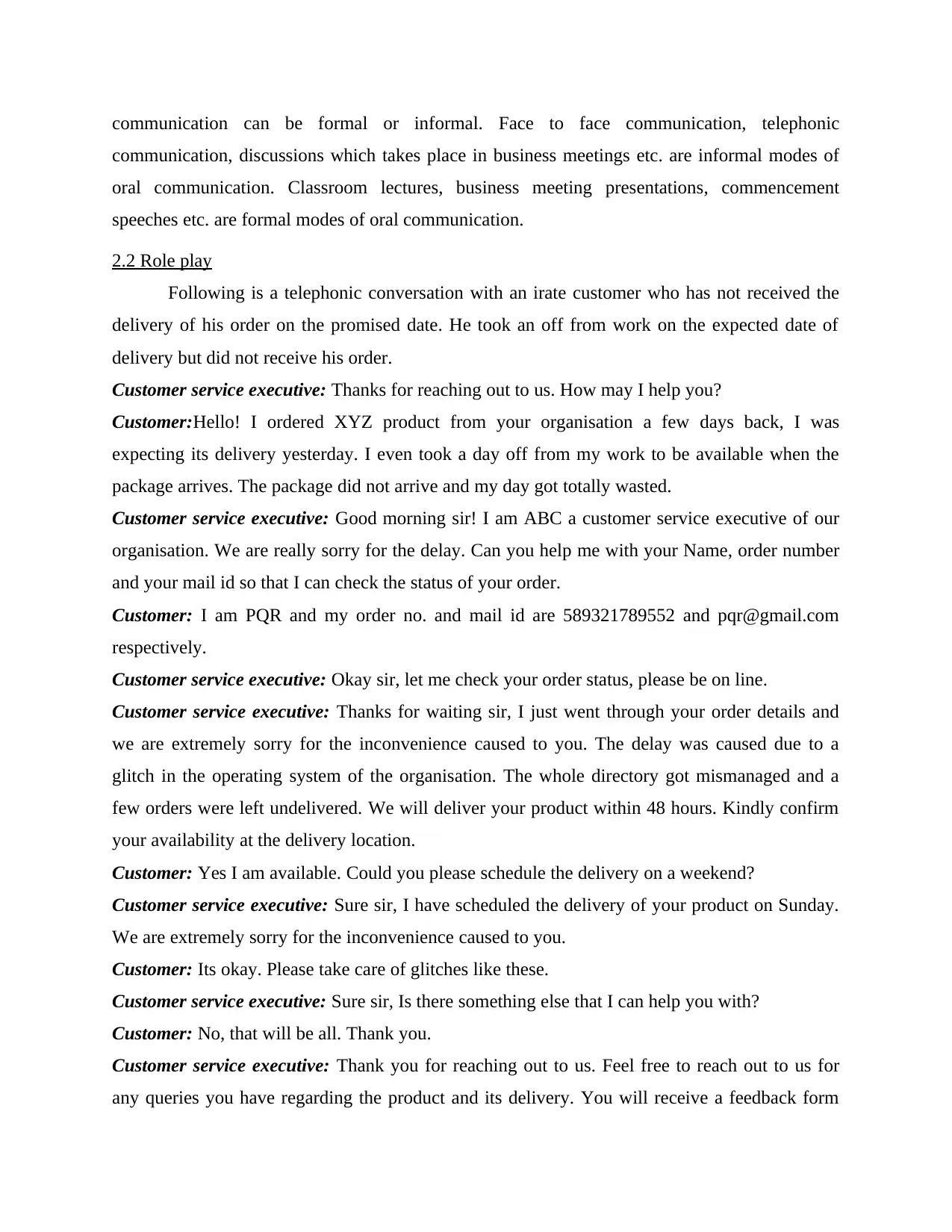
communication can be formal or informal. Face to face communication, telephonic
communication, discussions which takes place in business meetings etc. are informal modes of
oral communication. Classroom lectures, business meeting presentations, commencement
speeches etc. are formal modes of oral communication.
2.2 Role play
Following is a telephonic conversation with an irate customer who has not received the
delivery of his order on the promised date. He took an off from work on the expected date of
delivery but did not receive his order.
Customer service executive: Thanks for reaching out to us. How may I help you?
Customer:Hello! I ordered XYZ product from your organisation a few days back, I was
expecting its delivery yesterday. I even took a day off from my work to be available when the
package arrives. The package did not arrive and my day got totally wasted.
Customer service executive: Good morning sir! I am ABC a customer service executive of our
organisation. We are really sorry for the delay. Can you help me with your Name, order number
and your mail id so that I can check the status of your order.
Customer: I am PQR and my order no. and mail id are 589321789552 and pqr@gmail.com
respectively.
Customer service executive: Okay sir, let me check your order status, please be on line.
Customer service executive: Thanks for waiting sir, I just went through your order details and
we are extremely sorry for the inconvenience caused to you. The delay was caused due to a
glitch in the operating system of the organisation. The whole directory got mismanaged and a
few orders were left undelivered. We will deliver your product within 48 hours. Kindly confirm
your availability at the delivery location.
Customer: Yes I am available. Could you please schedule the delivery on a weekend?
Customer service executive: Sure sir, I have scheduled the delivery of your product on Sunday.
We are extremely sorry for the inconvenience caused to you.
Customer: Its okay. Please take care of glitches like these.
Customer service executive: Sure sir, Is there something else that I can help you with?
Customer: No, that will be all. Thank you.
Customer service executive: Thank you for reaching out to us. Feel free to reach out to us for
any queries you have regarding the product and its delivery. You will receive a feedback form
communication, discussions which takes place in business meetings etc. are informal modes of
oral communication. Classroom lectures, business meeting presentations, commencement
speeches etc. are formal modes of oral communication.
2.2 Role play
Following is a telephonic conversation with an irate customer who has not received the
delivery of his order on the promised date. He took an off from work on the expected date of
delivery but did not receive his order.
Customer service executive: Thanks for reaching out to us. How may I help you?
Customer:Hello! I ordered XYZ product from your organisation a few days back, I was
expecting its delivery yesterday. I even took a day off from my work to be available when the
package arrives. The package did not arrive and my day got totally wasted.
Customer service executive: Good morning sir! I am ABC a customer service executive of our
organisation. We are really sorry for the delay. Can you help me with your Name, order number
and your mail id so that I can check the status of your order.
Customer: I am PQR and my order no. and mail id are 589321789552 and pqr@gmail.com
respectively.
Customer service executive: Okay sir, let me check your order status, please be on line.
Customer service executive: Thanks for waiting sir, I just went through your order details and
we are extremely sorry for the inconvenience caused to you. The delay was caused due to a
glitch in the operating system of the organisation. The whole directory got mismanaged and a
few orders were left undelivered. We will deliver your product within 48 hours. Kindly confirm
your availability at the delivery location.
Customer: Yes I am available. Could you please schedule the delivery on a weekend?
Customer service executive: Sure sir, I have scheduled the delivery of your product on Sunday.
We are extremely sorry for the inconvenience caused to you.
Customer: Its okay. Please take care of glitches like these.
Customer service executive: Sure sir, Is there something else that I can help you with?
Customer: No, that will be all. Thank you.
Customer service executive: Thank you for reaching out to us. Feel free to reach out to us for
any queries you have regarding the product and its delivery. You will receive a feedback form
Secure Best Marks with AI Grader
Need help grading? Try our AI Grader for instant feedback on your assignments.
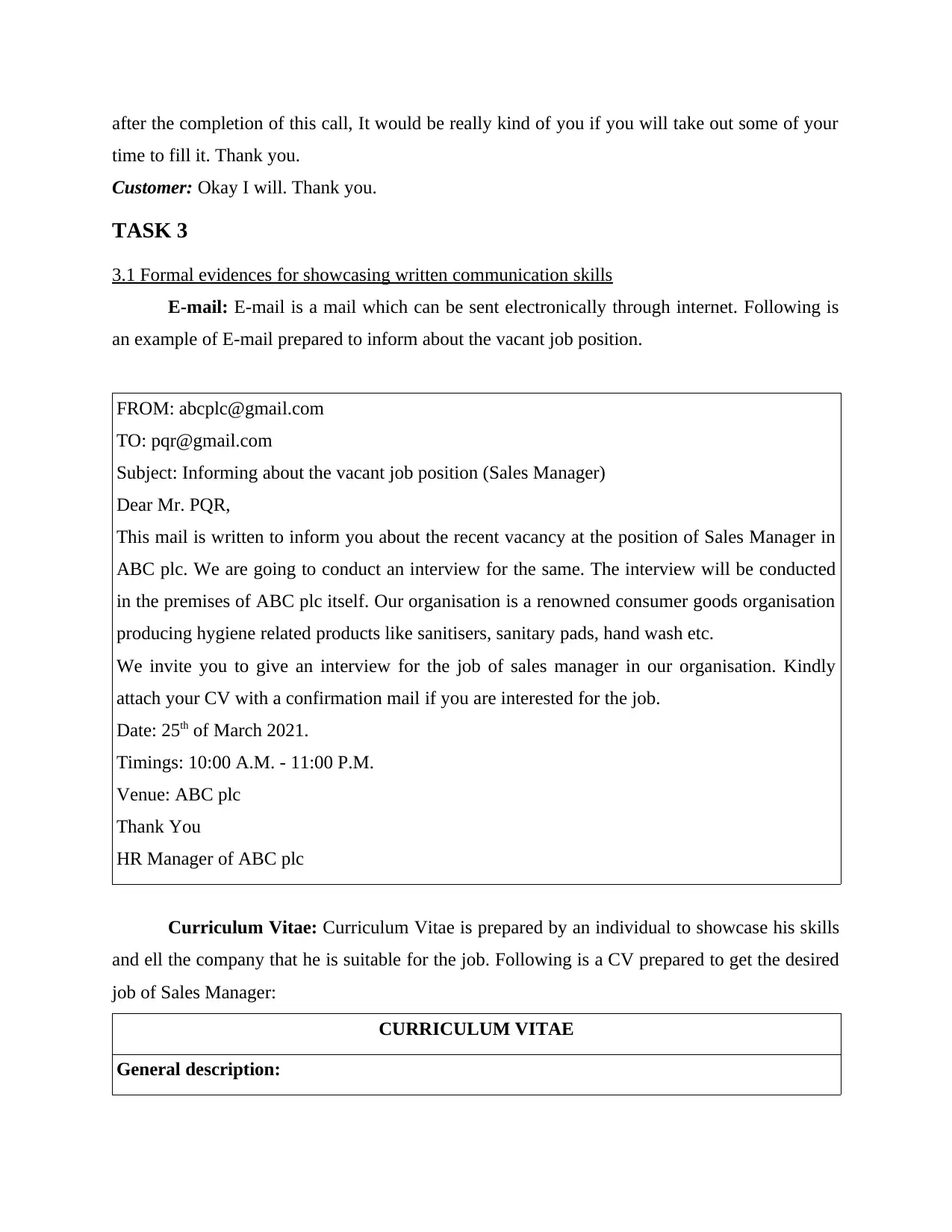
after the completion of this call, It would be really kind of you if you will take out some of your
time to fill it. Thank you.
Customer: Okay I will. Thank you.
TASK 3
3.1 Formal evidences for showcasing written communication skills
E-mail: E-mail is a mail which can be sent electronically through internet. Following is
an example of E-mail prepared to inform about the vacant job position.
FROM: abcplc@gmail.com
TO: pqr@gmail.com
Subject: Informing about the vacant job position (Sales Manager)
Dear Mr. PQR,
This mail is written to inform you about the recent vacancy at the position of Sales Manager in
ABC plc. We are going to conduct an interview for the same. The interview will be conducted
in the premises of ABC plc itself. Our organisation is a renowned consumer goods organisation
producing hygiene related products like sanitisers, sanitary pads, hand wash etc.
We invite you to give an interview for the job of sales manager in our organisation. Kindly
attach your CV with a confirmation mail if you are interested for the job.
Date: 25th of March 2021.
Timings: 10:00 A.M. - 11:00 P.M.
Venue: ABC plc
Thank You
HR Manager of ABC plc
Curriculum Vitae: Curriculum Vitae is prepared by an individual to showcase his skills
and ell the company that he is suitable for the job. Following is a CV prepared to get the desired
job of Sales Manager:
CURRICULUM VITAE
General description:
time to fill it. Thank you.
Customer: Okay I will. Thank you.
TASK 3
3.1 Formal evidences for showcasing written communication skills
E-mail: E-mail is a mail which can be sent electronically through internet. Following is
an example of E-mail prepared to inform about the vacant job position.
FROM: abcplc@gmail.com
TO: pqr@gmail.com
Subject: Informing about the vacant job position (Sales Manager)
Dear Mr. PQR,
This mail is written to inform you about the recent vacancy at the position of Sales Manager in
ABC plc. We are going to conduct an interview for the same. The interview will be conducted
in the premises of ABC plc itself. Our organisation is a renowned consumer goods organisation
producing hygiene related products like sanitisers, sanitary pads, hand wash etc.
We invite you to give an interview for the job of sales manager in our organisation. Kindly
attach your CV with a confirmation mail if you are interested for the job.
Date: 25th of March 2021.
Timings: 10:00 A.M. - 11:00 P.M.
Venue: ABC plc
Thank You
HR Manager of ABC plc
Curriculum Vitae: Curriculum Vitae is prepared by an individual to showcase his skills
and ell the company that he is suitable for the job. Following is a CV prepared to get the desired
job of Sales Manager:
CURRICULUM VITAE
General description:
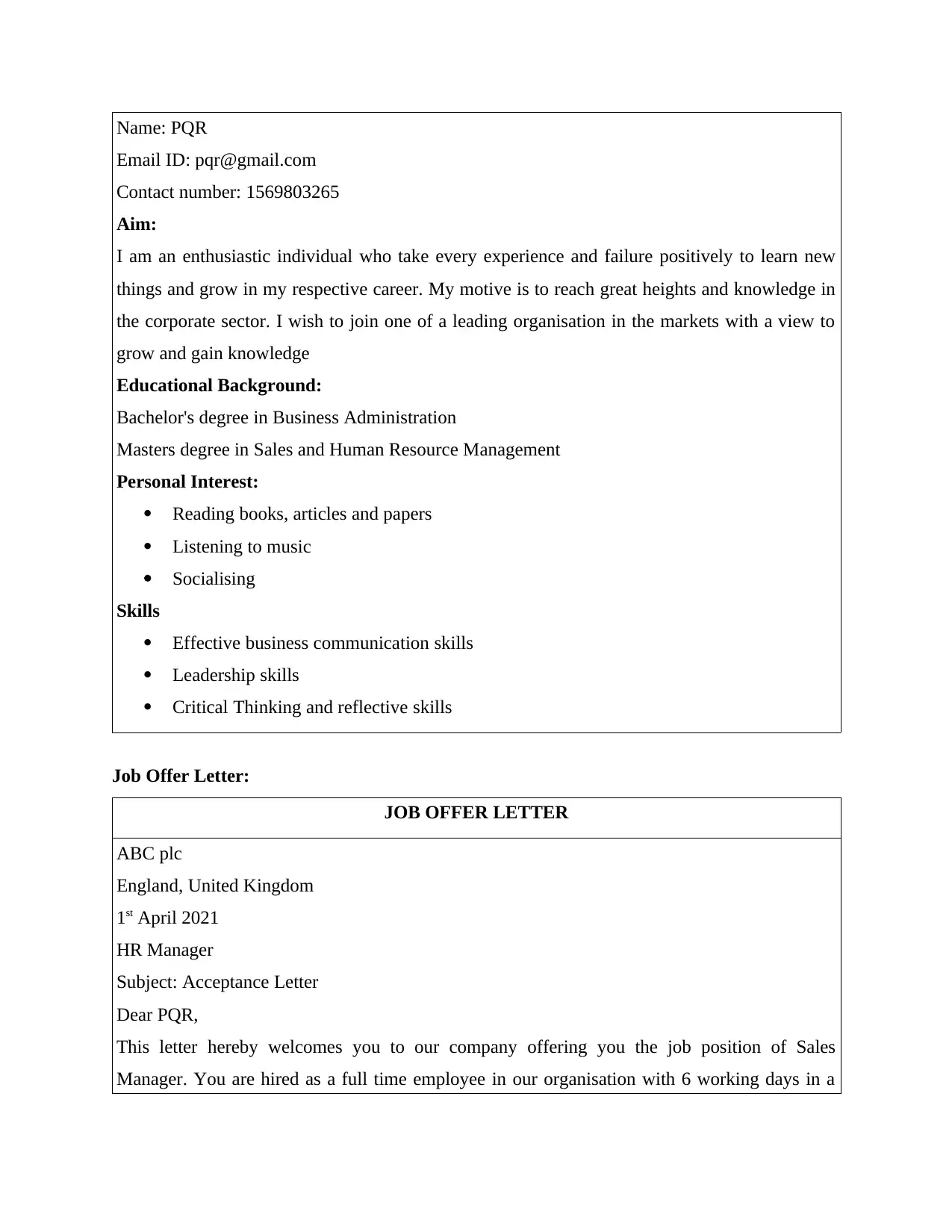
Name: PQR
Email ID: pqr@gmail.com
Contact number: 1569803265
Aim:
I am an enthusiastic individual who take every experience and failure positively to learn new
things and grow in my respective career. My motive is to reach great heights and knowledge in
the corporate sector. I wish to join one of a leading organisation in the markets with a view to
grow and gain knowledge
Educational Background:
Bachelor's degree in Business Administration
Masters degree in Sales and Human Resource Management
Personal Interest:
Reading books, articles and papers
Listening to music
Socialising
Skills
Effective business communication skills
Leadership skills
Critical Thinking and reflective skills
Job Offer Letter:
JOB OFFER LETTER
ABC plc
England, United Kingdom
1st April 2021
HR Manager
Subject: Acceptance Letter
Dear PQR,
This letter hereby welcomes you to our company offering you the job position of Sales
Manager. You are hired as a full time employee in our organisation with 6 working days in a
Email ID: pqr@gmail.com
Contact number: 1569803265
Aim:
I am an enthusiastic individual who take every experience and failure positively to learn new
things and grow in my respective career. My motive is to reach great heights and knowledge in
the corporate sector. I wish to join one of a leading organisation in the markets with a view to
grow and gain knowledge
Educational Background:
Bachelor's degree in Business Administration
Masters degree in Sales and Human Resource Management
Personal Interest:
Reading books, articles and papers
Listening to music
Socialising
Skills
Effective business communication skills
Leadership skills
Critical Thinking and reflective skills
Job Offer Letter:
JOB OFFER LETTER
ABC plc
England, United Kingdom
1st April 2021
HR Manager
Subject: Acceptance Letter
Dear PQR,
This letter hereby welcomes you to our company offering you the job position of Sales
Manager. You are hired as a full time employee in our organisation with 6 working days in a
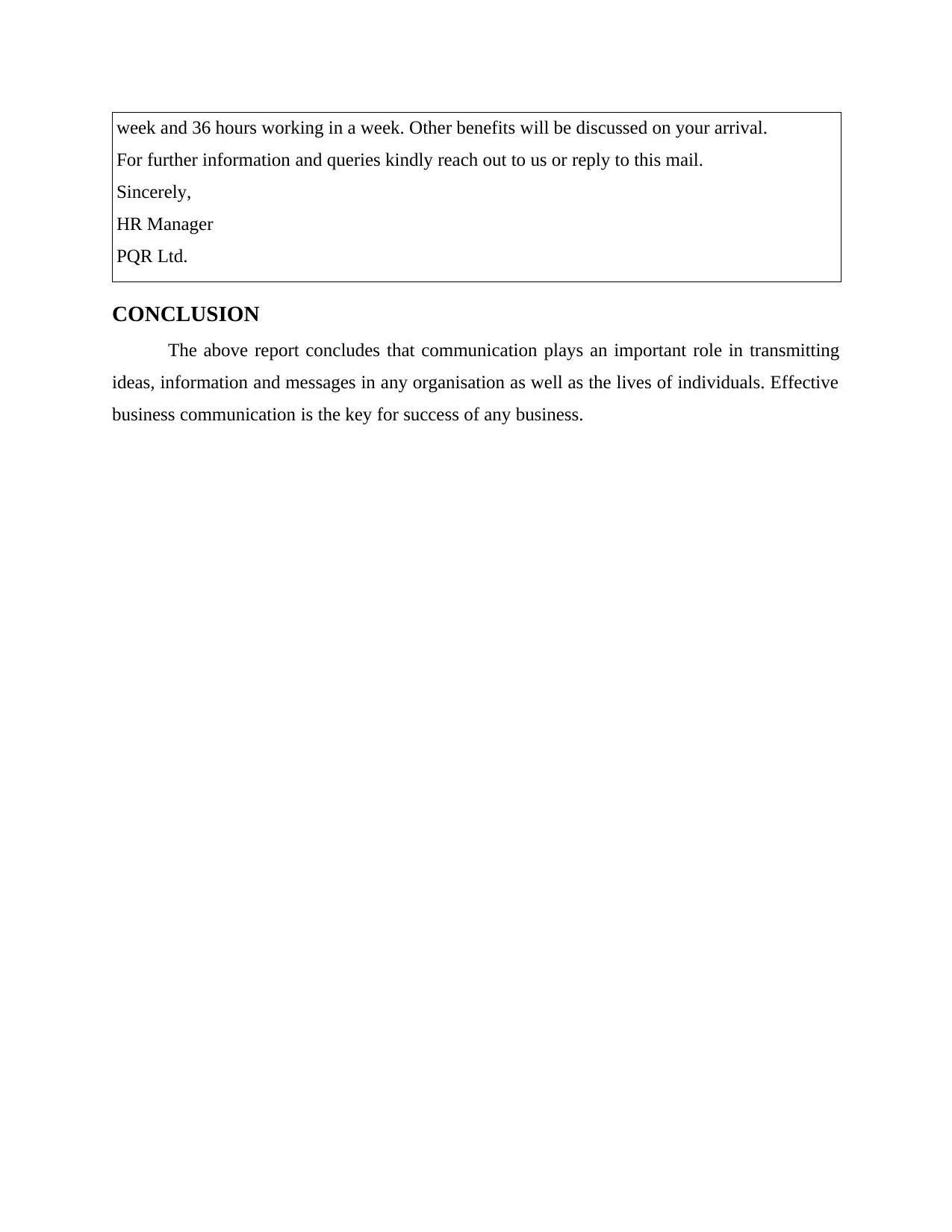
week and 36 hours working in a week. Other benefits will be discussed on your arrival.
For further information and queries kindly reach out to us or reply to this mail.
Sincerely,
HR Manager
PQR Ltd.
CONCLUSION
The above report concludes that communication plays an important role in transmitting
ideas, information and messages in any organisation as well as the lives of individuals. Effective
business communication is the key for success of any business.
For further information and queries kindly reach out to us or reply to this mail.
Sincerely,
HR Manager
PQR Ltd.
CONCLUSION
The above report concludes that communication plays an important role in transmitting
ideas, information and messages in any organisation as well as the lives of individuals. Effective
business communication is the key for success of any business.
Paraphrase This Document
Need a fresh take? Get an instant paraphrase of this document with our AI Paraphraser
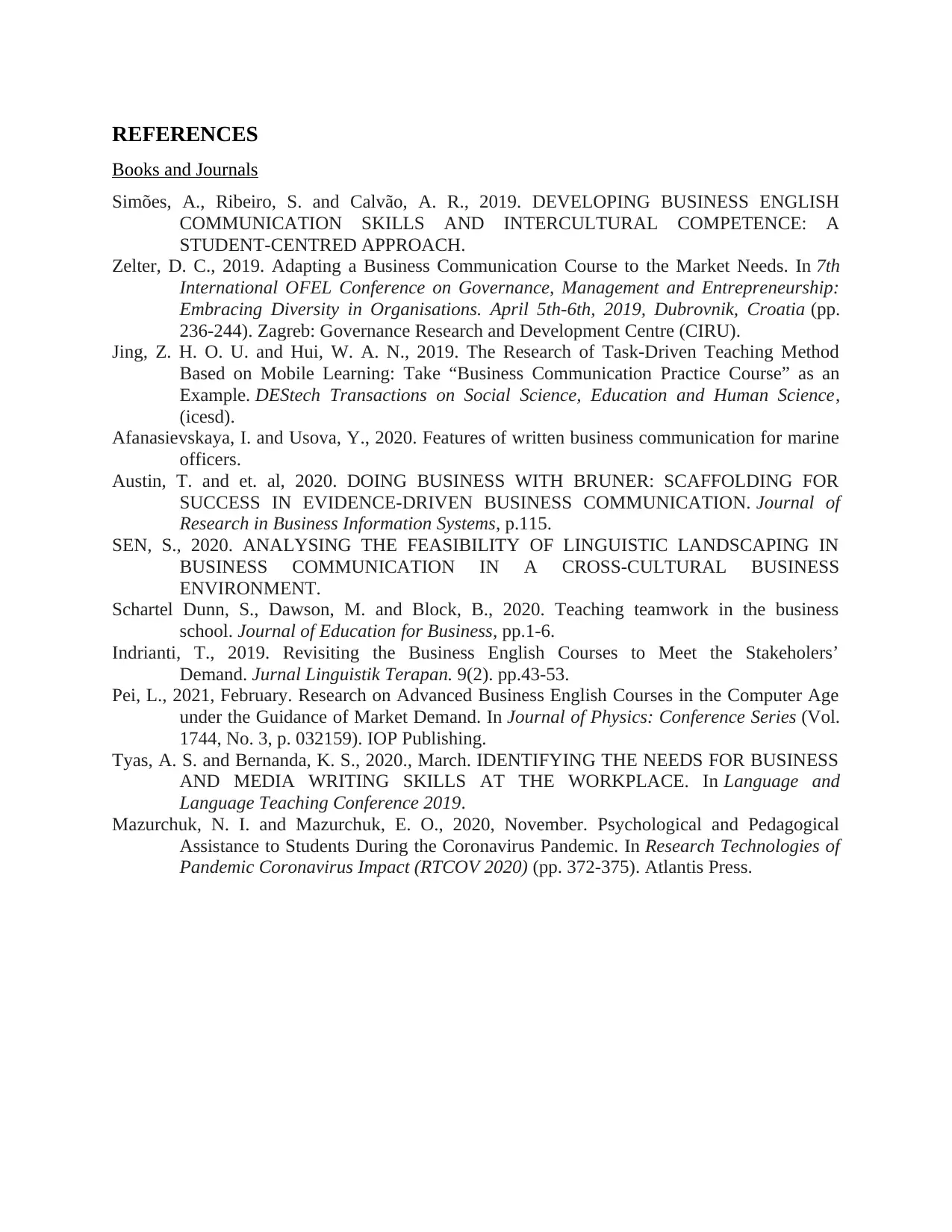
REFERENCES
Books and Journals
Simões, A., Ribeiro, S. and Calvão, A. R., 2019. DEVELOPING BUSINESS ENGLISH
COMMUNICATION SKILLS AND INTERCULTURAL COMPETENCE: A
STUDENT-CENTRED APPROACH.
Zelter, D. C., 2019. Adapting a Business Communication Course to the Market Needs. In 7th
International OFEL Conference on Governance, Management and Entrepreneurship:
Embracing Diversity in Organisations. April 5th-6th, 2019, Dubrovnik, Croatia (pp.
236-244). Zagreb: Governance Research and Development Centre (CIRU).
Jing, Z. H. O. U. and Hui, W. A. N., 2019. The Research of Task-Driven Teaching Method
Based on Mobile Learning: Take “Business Communication Practice Course” as an
Example. DEStech Transactions on Social Science, Education and Human Science,
(icesd).
Afanasievskaya, I. and Usova, Y., 2020. Features of written business communication for marine
officers.
Austin, T. and et. al, 2020. DOING BUSINESS WITH BRUNER: SCAFFOLDING FOR
SUCCESS IN EVIDENCE-DRIVEN BUSINESS COMMUNICATION. Journal of
Research in Business Information Systems, p.115.
SEN, S., 2020. ANALYSING THE FEASIBILITY OF LINGUISTIC LANDSCAPING IN
BUSINESS COMMUNICATION IN A CROSS-CULTURAL BUSINESS
ENVIRONMENT.
Schartel Dunn, S., Dawson, M. and Block, B., 2020. Teaching teamwork in the business
school. Journal of Education for Business, pp.1-6.
Indrianti, T., 2019. Revisiting the Business English Courses to Meet the Stakeholers’
Demand. Jurnal Linguistik Terapan. 9(2). pp.43-53.
Pei, L., 2021, February. Research on Advanced Business English Courses in the Computer Age
under the Guidance of Market Demand. In Journal of Physics: Conference Series (Vol.
1744, No. 3, p. 032159). IOP Publishing.
Tyas, A. S. and Bernanda, K. S., 2020., March. IDENTIFYING THE NEEDS FOR BUSINESS
AND MEDIA WRITING SKILLS AT THE WORKPLACE. In Language and
Language Teaching Conference 2019.
Mazurchuk, N. I. and Mazurchuk, E. O., 2020, November. Psychological and Pedagogical
Assistance to Students During the Coronavirus Pandemic. In Research Technologies of
Pandemic Coronavirus Impact (RTCOV 2020) (pp. 372-375). Atlantis Press.
Books and Journals
Simões, A., Ribeiro, S. and Calvão, A. R., 2019. DEVELOPING BUSINESS ENGLISH
COMMUNICATION SKILLS AND INTERCULTURAL COMPETENCE: A
STUDENT-CENTRED APPROACH.
Zelter, D. C., 2019. Adapting a Business Communication Course to the Market Needs. In 7th
International OFEL Conference on Governance, Management and Entrepreneurship:
Embracing Diversity in Organisations. April 5th-6th, 2019, Dubrovnik, Croatia (pp.
236-244). Zagreb: Governance Research and Development Centre (CIRU).
Jing, Z. H. O. U. and Hui, W. A. N., 2019. The Research of Task-Driven Teaching Method
Based on Mobile Learning: Take “Business Communication Practice Course” as an
Example. DEStech Transactions on Social Science, Education and Human Science,
(icesd).
Afanasievskaya, I. and Usova, Y., 2020. Features of written business communication for marine
officers.
Austin, T. and et. al, 2020. DOING BUSINESS WITH BRUNER: SCAFFOLDING FOR
SUCCESS IN EVIDENCE-DRIVEN BUSINESS COMMUNICATION. Journal of
Research in Business Information Systems, p.115.
SEN, S., 2020. ANALYSING THE FEASIBILITY OF LINGUISTIC LANDSCAPING IN
BUSINESS COMMUNICATION IN A CROSS-CULTURAL BUSINESS
ENVIRONMENT.
Schartel Dunn, S., Dawson, M. and Block, B., 2020. Teaching teamwork in the business
school. Journal of Education for Business, pp.1-6.
Indrianti, T., 2019. Revisiting the Business English Courses to Meet the Stakeholers’
Demand. Jurnal Linguistik Terapan. 9(2). pp.43-53.
Pei, L., 2021, February. Research on Advanced Business English Courses in the Computer Age
under the Guidance of Market Demand. In Journal of Physics: Conference Series (Vol.
1744, No. 3, p. 032159). IOP Publishing.
Tyas, A. S. and Bernanda, K. S., 2020., March. IDENTIFYING THE NEEDS FOR BUSINESS
AND MEDIA WRITING SKILLS AT THE WORKPLACE. In Language and
Language Teaching Conference 2019.
Mazurchuk, N. I. and Mazurchuk, E. O., 2020, November. Psychological and Pedagogical
Assistance to Students During the Coronavirus Pandemic. In Research Technologies of
Pandemic Coronavirus Impact (RTCOV 2020) (pp. 372-375). Atlantis Press.
1 out of 14
Related Documents
Your All-in-One AI-Powered Toolkit for Academic Success.
+13062052269
info@desklib.com
Available 24*7 on WhatsApp / Email
![[object Object]](/_next/static/media/star-bottom.7253800d.svg)
Unlock your academic potential
© 2024 | Zucol Services PVT LTD | All rights reserved.





